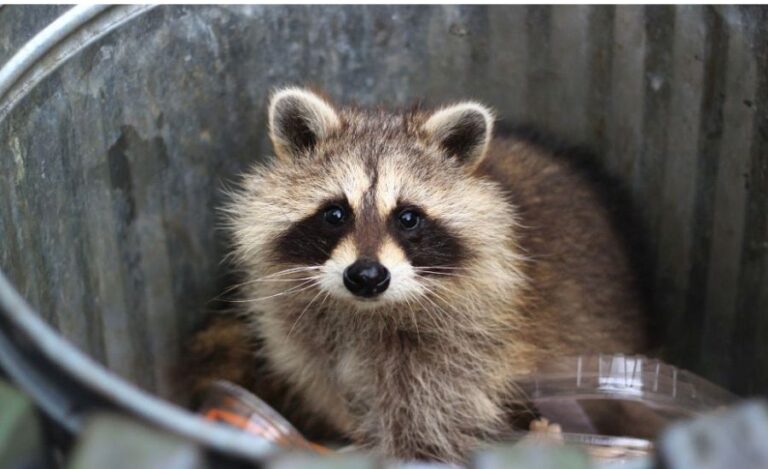Raccoon tracks in your yard indicate a presence you might not have noticed before. These footprints, typically characterized by their distinct claw marks and unique shape, reveal a lot about the activity of these curious creatures. Identifying raccoon tracks in your yard can help you understand their behavior and how to coexist with them effectively.
If you find these tracks, you must learn what they suggest about food sources or potential nesting spots nearby. Raccoons are typically attracted to gardens, trash bins, and areas where food is easily accessible. Observing the tracks, you uncover patterns that help you mitigate unwanted future visits.
Understanding what raccoon tracks look like can prepare you for encounters and equip you with knowledge to protect your property. This article will give you the tools to identify these tracks and address the challenges of sharing your space with raccoons.
Identifying Raccoon Activity

Recognizing signs of raccoon activity in your yard is crucial for understanding their presence and potential impact on your property. You can determine if raccoons frequent your area by analyzing their tracks, identifying damage, and noting other signs.
Analyzing Raccoon Tracks
Raccoon tracks are distinct and can easily be identified. They typically display a size of about 2.5 to 4 inches long. The front paws have five toes with a noticeable claw mark, while the back paws are slightly larger and narrower.
To spot these footprints, look for them in muddy areas, soft soil, or near water sources. You may see three to five parallel scratches from their claws. Finding tracks leading toward or away from your garden or yard strongly indicates recent raccoon activity.
Recognizing Raccoon Damage
Raccoon damage can manifest in various forms. In Frisco, you might notice signs such as overturned trash cans, disturbed landscaping, or ripped-open bags. Raccoons are known for their dexterous paws, which allow them to open lids and access food easily.
Take note of any holes or scratches around your property. Raccoons may create openings in fences or sheds when foraging for food. Damage to gardens is also typical; look for signs like dug-up plants or uprooted vegetation, which could indicate their presence in your garden.
Signs of Raccoon Presence
In addition to tracks and damage, there are other clear signs of raccoon activity. Pay attention to raccoon droppings in your garden. They are usually dark and cylindrical and often contain undigested food remnants, which can indicate regular visits.
You may hear raccoon noises at night, such as chattering or scuffling sounds. This is particularly noticeable in suburban areas of Frisco. If you detect these sounds coming from your yard, it strongly indicates that raccoons are nearby.
Preventing and Managing Raccoons

It is essential to take proactive steps to prevent raccoons from entering your yard. Addressing entry points, using deterrents, and knowing when to call for professional help can significantly reduce encounters with these creatures.
Securing Potential Entry Points
Raccoons are skilled climbers and can access your yard through various entry points. Inspect your property for potential access areas, including:
- Gaps in Fences: Ensure fences are at least four feet high and have no gaps or broken sections.
- Open Vents and Chimneys: Install screens or caps to close off these openings.
- Garbage Cans: Use raccoon-proof bins with tight-fitting lids to avoid attracting them.
Check your yard regularly for raccoon tracks, as this can indicate recent activity. Addressing these entry points helps keep raccoons out and minimizes the risk of other wildlife intrusions.
Deterring Future Visits
Once you secure entry points, consider implementing additional deterrents to reduce the likelihood of future visits. Effective methods include:
- Motion-Activated Lights: Sudden brightness can startle raccoons, making your yard less appealing.
- Noise Makers: Wind chimes or ultrasonic devices can disrupt their usual behavior.
- Repellents: Commercial raccoon repellents or homemade solutions like vinegar or cayenne pepper can effectively keep them away.
You should also maintain a clean yard by removing food sources such as pet food, fallen fruit, and compost. This proactive approach can significantly lower the chances of raccoons making your yard their home.
Calling Professional Help
If you continue encountering raccoons despite your efforts, it may be time to seek professional assistance. Trained wildlife removal experts can assess your property and identify hidden entry points.
Contact Critter Stop at (214) 234-2616 for a free inspection. Their team specializes in humane wildlife removal and can help you effectively manage raccoon-related issues. With excellent customer reviews and a solid reputation in the community, they ensure high-quality work and outstanding customer service to address your wildlife concerns.
Stay informed with the latest news and updates on Dallasinsiders.com
